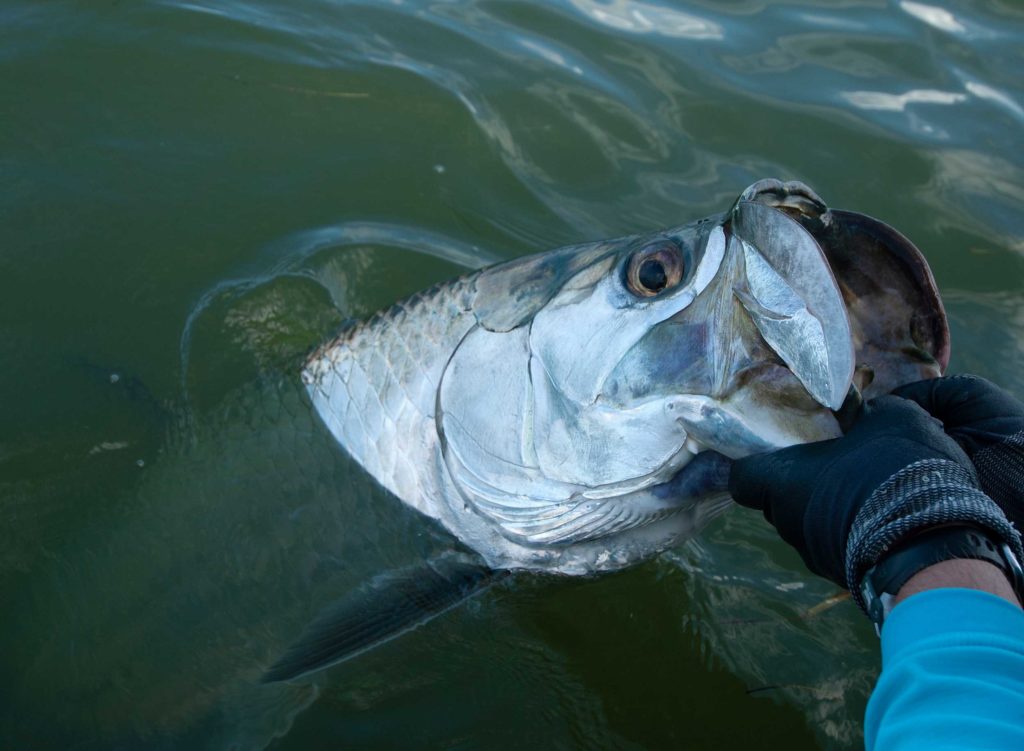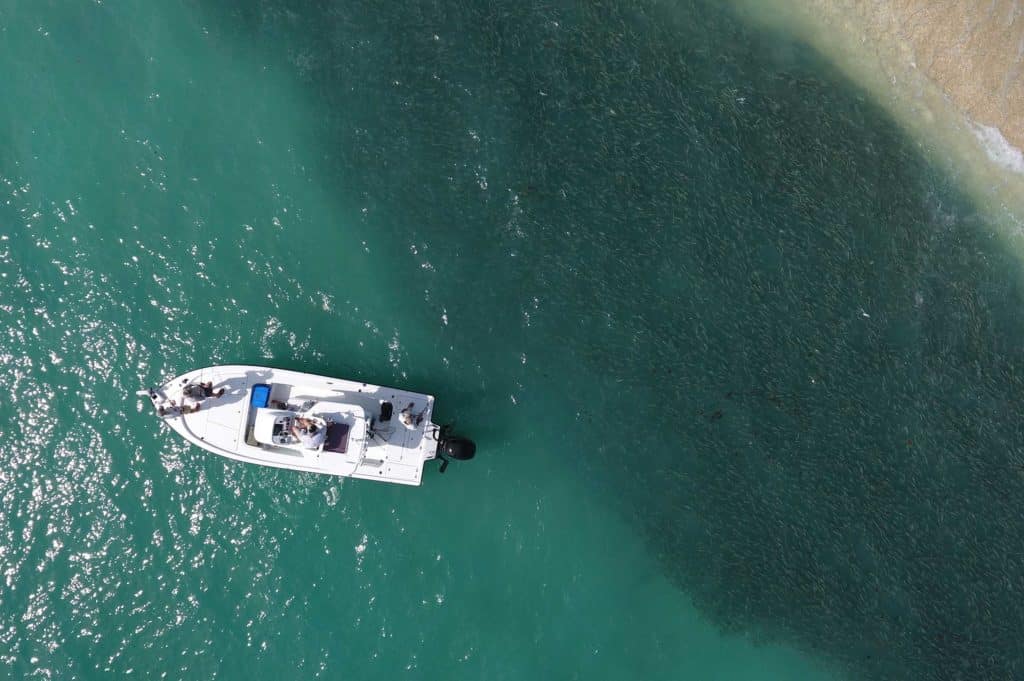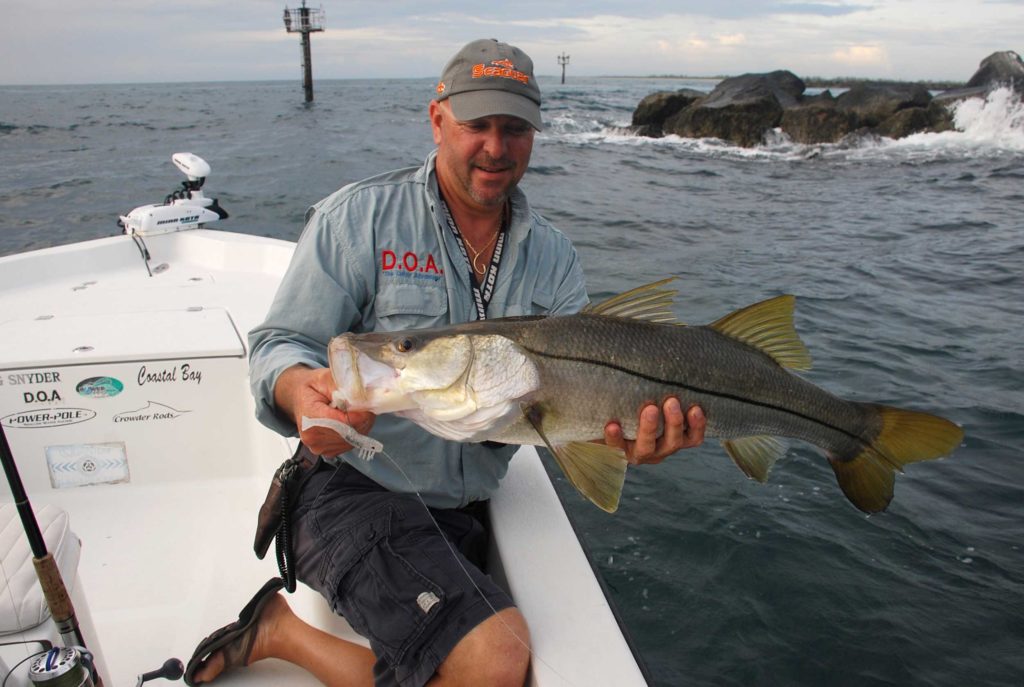
People who complain that South Florida doesn’t enjoy a change of seasons don’t fish the annual fall mullet run.
To anglers from Stuart to Key Largo, nothing signals that fall has arrived like the migration of these baitfish. Silver and black mullet move south in enormous schools along the Atlantic coast, all the while dodging a host of predators such as snook, tarpon, jacks, sharks, Spanish mackerel and bluefish. October marks the prime time to fish the mullet run, both offshore and inshore.
The Game Plan
Anglers never know what they might catch from one cast to the next. They don’t even need live mullet to catch the gamefish species. Half a mullet, topwater plugs, spoons, and soft-plastic bait imitations can be as effective if not more.
“There’s definitely a wave of mullet coming in,” says Capt. Chris Murray of Stuart, who fishes offshore as well as in the Indian and St. Lucie rivers. “They come in in droves, and then they’ll pause, and then there’ll be another drove.”
“We’ve got them both inshore and offshore right now,” adds Capt. Mark Nichols, founder of D.O.A. Fishing Lures. “It seems like there are a lot of mullet in the rivers. They could be here for another several weeks or a month. It just depends on whether the weather pushes them south.”
Murray usually nets several dozen mullet wherever he sees the baitfish pushing water. After catching bait, he cruises around until he spots another mullet school. Then he closely watches to see what the baitfish are doing and what’s feeding on them.
Tarpon often jump completely out of the water, then come crashing back into the middle of the school. Snook hang below the school and suck in mullet with an audible pop. Jacks charge into the school and send mullet flying.

Murray likes to fish live mullet on a 7-foot, light- to medium-action spinning rod with a 4000-size reel spooled with 20-pound braided line. He usually attaches a 40-pound fluorocarbon leader with a 3/0 Owner Mutu Light circle hook and clips an indicator float to the leader, which allows him and his anglers to keep track of the bait.
“I vary my leaders. I like to actually start lighter,” Murray says. “Normally I rig up two that are 25-pound, two that are 30, two that are 40. When I know what kind of fish are there and what kind of heat I have to put on them, normally 40. If they’re short snook, 25 or 30 is fine.”
When drifting or slow-trolling, he hooks a mullet through the upper lip and casts it to the edge of a submerged oyster bar, which snook, tarpon and other species use as ambush spots. Murray then opens the bail of the reel and slowly lets out line.

Jacks Are Wild
On one trip I took in the St. Lucie River with Murray and Anthony Javarone, we cast out, and only moments later, I felt my mullet get very nervous. Suddenly violent splashes erupted, and whatever had scared my mullet nailed Javarone’s bait.
Following Murray’s instruction to let the fish swim for a few seconds before closing the bail and reeling tight, Javarone hooked up to what turned out to be a 15-pound jack. The fish took Javarone from one end of Murray’s bay boat to the other before it finally tired.
“Those big jacks are great practice for people who want snook and tarpon,” Murray says. “They’re a guide’s best friend. They just give you every chance to develop your rhythm.”
When jacks, tarpon and Spanish mackerel successfully raid the schools for a meal, they often stun and maim a few of the baits, which fall to the sea floor. That’s when fishing a mullet head on the bottom can be extremely effective.
The Change-Up
Fishing around the rocks at the mouth of Stuart’s St. Lucie Inlet, Capt. Greg Snyder uses a D.O.A. plastic shrimp to catch all sizes of snook, from under the minimum size limit of 28 inches to over the maximum of 32 inches. He fishes the shrimp on a spinning outfit with 30-pound braided line and a 40-pound fluorocarbon leader.
“They use the rocks as a trap,” Snyder says of the snook. “The bait hits the rocks and gets confused, and the snook take advantage of it.”
Let the shrimp drift with the current and be aware of any taps or hesitation in the drift, because that means a snook has taken the lure. “Let the tide do the work, and keep in contact with the shrimp,” he says, “because you need to be able to set the hook when they eat.”
Why would a snook eat a shrimp when mullet are abundant? I posed that question to D.O.A. luremaker Nichols. “During the first of the mullet run, the fish are all over the mullet,” he says. “But after three weeks of eating mullet, they’re ready for something different.”

I witnessed that fishing with Nichols in the north fork of the St. Lucie River on the last half of a falling tide. His flats skiff was surrounded by mullet and rolling tarpon, but after we threw some DOA soft-plastic mullet imitations such as a Bait Buster and a TerrorEyz without a bite, Nichols switched us to DOA glow shrimp.
Standing at the front of the boat, we waited until a tarpon rolled within casting distance. Then we cast the shrimp just ahead of the tarpon. Instead of steadily twitching the shrimp back to the boat, Nichols advises working it slowly.
“You want the shrimp to go down,” he says. “Then snap the rod and jerk the shrimp sharply, but don’t crank the reel and move the shrimp away. You want it to stay right where the fish was.”
Picture it in these terms: Here’s a shrimp, slowly sinking in the water. Suddenly it jumps up, then sinks right back down. The next time it jumps, thinking it might get away, the tarpon eats it. Using that technique, Nichols and I enjoyed about two dozen tarpon bites.
“I think it’s just easy for them to eat a shrimp,” he says. “They have to work hard to catch a mullet. It doesn’t take anything for them to catch a shrimp.”
Read Next: Mesmerizing Drone Video Shows Tarpon Attacking Mullet
Two other advantages of fishing an artificial shrimp around a mullet school: Bait stealers don’t peck at a plastic shrimp like they do a live shrimp, and Nichols can fish his shrimp exactly how he wants.
To make a D.O.A. shrimp more appealing to a fish keying on a school of mullet, Nichols fishes it below the school or on the edge of the school. That makes the shrimp look vulnerable, which makes it an easy target.
“If you’re not catching fish with a shrimp, you’re fishing it too fast,” Nichols says. “No matter how slowly you think you’re fishing it, fish it slower.”








